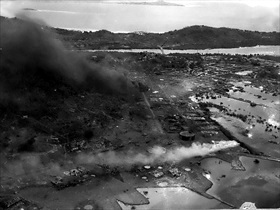JAPANESE TRUK TARGET OF NAVY AIR/SEA ATTACK
Task Force 58 Off Truk (Chuuk), Central Pacific • February 17, 1944
Chuuk Lagoon, known up to 1990 as Truk Lagoon, is a sheltered body of water in the Central Pacific north of New Guinea. Consisting of 11 major islands, Chuuk is part of the larger Caroline Islands group. Truk was part of the Spanish East Indies until the Spanish-American War (1898), after which control shifted to Germany. Following Germany’s defeat in World War I, Truk became a possession of the Japanese Empire under a League of Nations mandate.
Between the war years the Japanese made Truk their principal supply and repair base in the Central Pacific, a sort of “Japanese Pearl Harbor,” stationing close to 28,000 naval personnel and 18,000 army personnel there. Truk was the base for Japanese operations against Allied forces in New Guinea and the Solomon Islands. Due to its heavy fortifications, both manmade and natural, Truk was known to the Allies as “the Gibraltar of the Pacific.”
On this date, February 17, 1944, U.S. Naval Task Force 58, consisting of 12 carriers, 7 battleships, 45 other ships, and 10 submarines under the command of Vice Adm. Marc “Pete” Mitscher, began a 2‑day pounding of Truk. Operation Hailstone destroyed most of the Japanese airstrips, 270 aircraft (56 in air combat), the torpedo boat station, submarine repair shops, a communications center, a radar station, 3 cruisers, 4 destroyers, 17 transports, 4 fleet tankers, and 32 merchant ships, making Truk lagoon the biggest graveyard of ships in the world. The Japanese Navy saved its larger warships from destruction by moving them the week before to their base at Palau at the extreme western end of the Caroline Islands. Owing to the damage and the inability of the Japanese to continue using Truk as a forward base in the Central Pacific, the Allies were able to bypass the island and isolate it, practically starving its garrison along with the Trukese.
The attacks on Truk and later Palau during February and March 1944 had a crucial effect on the war: a third or so of all tankers assigned to the Japanese Combined Fleet was sunk, which was to impair future fleet operations of the ship-poor Imperial Navy during the climatic campaign of the Pacific War, Operation Forager—the Mariana and Palau Islands campaign (June–November 1944).
Operation Hailstone, the February 1944 Destruction of the Japanese Central Pacific Base at Truk (Chuuk) Atoll
 |
Above: Truk (known today as Chuuk) was the key logistical and operational hub supporting Japan’s perimeter defenses in the Central and South Pacific. It lay between 625 and 675 miles/1,005 and 1086 kilometers to the east of the Mariana Islands (Saipan, Tinian, and Guam), which the U.S. wrestled from Japanese control in mid-1944 and where the U.S. built bases for their B‑29 Superfortress long-range bombers that assaulted Japan’s major population and manufacturing centers in 1945.
 |  |
Left: Navy aviators surprised Japanese warships at anchor during Operation Hailstone, the U.S. raid on Truk, February 17–18, 1944. Adm. Mitscher’s self-effacing comment on the air-sea raid was, “All I knew about Truk was what I’d read in the National Geographic.” In June Mitscher’s aviators devastated more Japanese assets in the Battle of the Philippine Sea—also known as the “Great Marianas Turkey Shoot.”
![]()
Right: Navy Douglas SBD-5 Dauntless dive bombers from a USS Lexington bombing squadron fly low over Japanese installations on Param Island, Truk Atoll. Note the smoke rising from damaged buildings.
 |  |
Left: Aerial photo showing the destruction resulting from the surprise U.S. raid on Truk. In addition to U.S. Navy carrier strikes, land-based Army Air Forces B‑24 and B‑29 bombers carried out their own extensive bombing campaign on Truk Atoll.
![]()
Right: A Japanese freighter in Truk Atoll is hit by a torpedo dropped from a VT‑10 (Torpedo Squadron 10) Grumman Avenger, February 17, 1944. Including the ground-breaking night attack of February 16/17, torpedo bombers from the USS Enterprise accounted for one‑third of the total shipping destroyed by Task Force 58’s attack on Truk Atoll.
 |  |
Left: Japanese ships being bombed during Operation Hailstone. The surprise raid managed to sink a great number of auxiliary vessels and warships in the Truk lagoon.
![]()
Right: Japanese ammunition ships in the Truk lagoon explode following a dive-bombing attack by a U.S. carrier-based plane, February 17, 1944. The aircrew that dropped the bomb on the ammunition ship Aikoku Maru went missing and was believed to have been caught in the terrific explosion.
Newsreel Showing the February 17–18, 1944, Destruction of the Japanese Base on Truk
![]()

 History buffs, there is good news! The Daily Chronicles of World War II is now available as an ebook for $4.99 on Amazon.com. Containing a year’s worth of dated entries from this website, the ebook brings the story of this tumultuous era to life in a compelling, authoritative, and succinct manner. Featuring inventive navigation aids, the ebook enables readers to instantly move forward or backward by month and date to different dated entries. Simple and elegant! Click
History buffs, there is good news! The Daily Chronicles of World War II is now available as an ebook for $4.99 on Amazon.com. Containing a year’s worth of dated entries from this website, the ebook brings the story of this tumultuous era to life in a compelling, authoritative, and succinct manner. Featuring inventive navigation aids, the ebook enables readers to instantly move forward or backward by month and date to different dated entries. Simple and elegant! Click 











